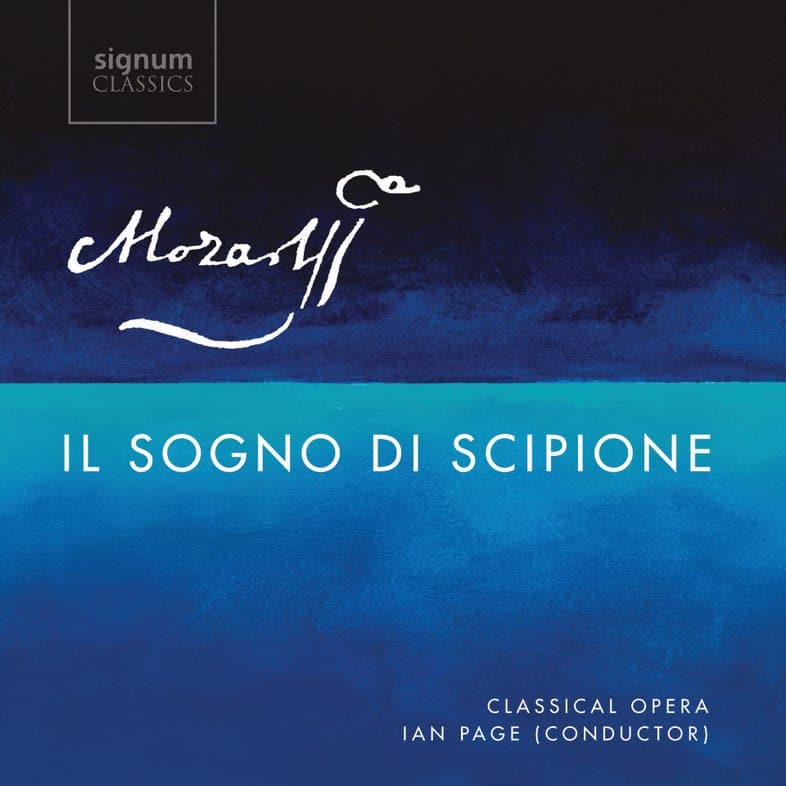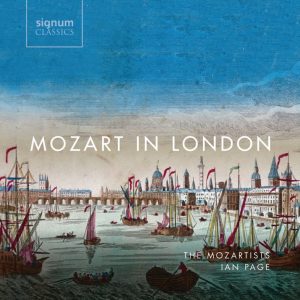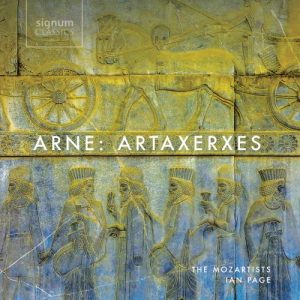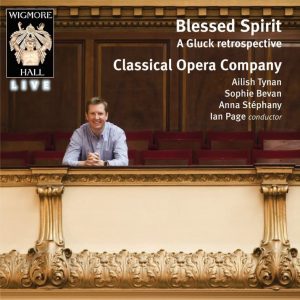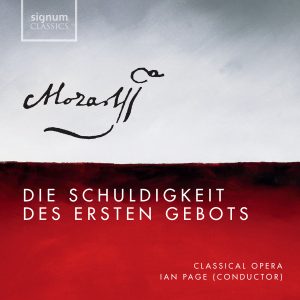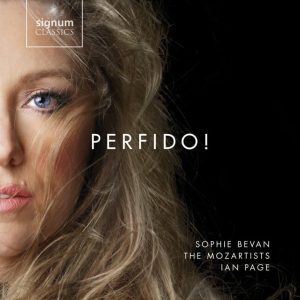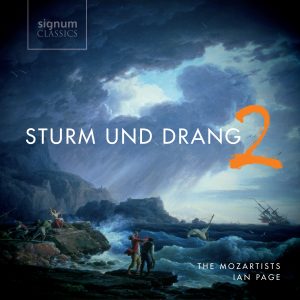“Ian Page and the Orchestra of Classical Opera have an unerring knack for making the most of the young Mozart’s characterful music.”
GRAMOPHONE
Classical Opera continues its critically acclaimed complete Mozart opera recording series on Signum Classics with the one-act dramatic serenade Il sogno di Scipione, K. 126. Conductor and artistic director Ian Page has assembled a cast comprising current Associate Artists soprano Soraya Mafi (Fortuna) and tenor Stuart Jackson (Scipio), as well as sopranos Klara Ek (Costanza) and Chiara Skerath (two licenza arias) and tenors Krystian Adam (Publio) and Robert Murray (Emilio). The sixth release in the series, following recordings of Apollo et Hyacinthus, Die Schuldigkeit des ersten Gebots, Mitridate, re di Ponto, Il re pastore and Zaide, Il sogno di Scipione is set in c.148 BC and was written as a homage to the Archbishop of Salzburg. It tells the story of the Roman general Scipio, a guest in the palace of his ally Massinissa, King of Numidia (in modern day Tunisia). As Scipio falls into a deep sleep, he dreams that the allegorical figures of Fortuna (Fortune) and Costanza (Constancy) appear to him in Elysium and demand that he should choose one of them to follow for the rest of his days. Mozart’s dramatic genius shows itself in two framing devices he uses to set up the story – the gradual subsidence of the overture into an unresolved hush depicting Scipio falling into a deep sleep, and the remarkable accompanied recitative in which Scipio eventually stirs from his dream – in which he composes music of sublime beauty and haunting otherworldliness. Ian Page says:
“In his early operas Mozart already demonstrates an unerring ability to match the scale and ambition of the music to the widely differing circumstances for which each work was written, no less so in Il sogno di Scipione. Mozart’s vocal writing is often virtuosic and demanding, and the orchestra already plays a dynamic role in evoking character and emotion.”
Il sogno di Scipione follows the much lauded ‘Perfido!’, a collection of concert arias by Mozart, Haydn and Beethoven sung by soprano Sophie Bevan with Ian Page’s The Mozartists, a new extension of Classical Opera reflecting their expanding concert work and broadening exploration of the music of Mozart and his contemporaries.
To order your copy, please click the ‘Add to cart’ button or download a digital version from one of the sites below:
CD 1
- Overtura05:23
- Recitativo: Vieni e siegui i miei passi0 2:16
- No. 1, Aria: Risolver non osa 06:45
- Recitativo: Giusta è la tua richiesta 00:29
- No. 2, Aria: Lieve sono al par del vento 07:09
- Recitativo: Dunque ove son? 02:40
- No. 3, Aria: Ciglio che al sol si gira0 8:03
- Recitativo: E quali abitatori… 00:28
- No. 4, Coro: Germe di cento eroi 02:39
- Recitativo: Numi! è vero, o m’inganno! 02:43
- No. 5, Aria: Se vuoi che te raccolgano 07:24
- Recitativo: Se qui vivon gli eroi 03:59
- No. 6, Aria: Voi colaggiù ridete 08:17
CD 2
- Recitativo: Publio, padre, ah lasciate 01:49
- No. 7, Aria: Quercia annosa su l’erte pendici 03:17
- Recitativo: Giacchè al voler de’ Fati 02:50
- No. 8, Aria: A chi serena io miro 06:53
- Recitativo: E a sì enorme possanza 02:16
- No. 9, Aria: Biancheggia in mar lo scoglio 07:09
- Recitativo: Non più. Bella Constanza 00:40
- No. 10, Aria: Dì che sei l’arbitra 07:15
- Recitativo accompagnato: E v’è mortal che ardisca 03:33
- Recitativo: Non è Scipio, o signore 00:34
- No. 11, Aria: Ah perchè cercar degg’io 08:29
- No. 12, Coro: Cento volte con lieto sembiante 01:37
- No. 11, Aria: Ah perchè cercar degg’io (original version) 03:31
The story of Scipio’s Dream takes place in c.148 BC, while the celebrated Roman general is a guest in the palace of his ally Massinissa, King of Numidia (in modern-day Tunisia). As Scipio falls into a deep sleep, he dreams that the allegorical figures of Fortuna (Fortune) and Costanza (Constancy) appear to him in Elysium and demand that he should choose one of them to follow for the rest of his days. Scipio feels that he needs more information to be able to make his decision, but Fortuna, in particular, is reluctant to allow him further time, acknowledging that she is as changeable and capricious as the wind. As Scipio admires the astonishing beauty of his surroundings, Costanza explains to him that on earth we are incapable of recognising such wonders, in the same way, that we have to turn away when we try to look into the sun.
Scipio enquires about the inhabitants of Elysium and is immediately visited by a chorus of dead heroes who include among their number his father Emilio (Lucius Aemilius) and his adoptive grandfather Publio (Publius Cornelius Scipio Africanus), both of whom have died heroically in military combat while serving their country. Publio explains that only their mortal bodies are dead, and he urges Scipio to live a life of virtue so that he in time can also live among the immortal heroes.
Scipio is perturbed that his father Emilio does not seem happy to see him, but Emilio explains that in heaven happiness is a much calmer and less demonstrative emotion. From their vantage point, the world appears like a tiny dot, and all the anxieties and agitations that we endure on earth now seem absurd and insignificant.
Scipio wishes to remain in Elysium, but Fortuna and Costanza insist that this is not yet permitted. Publio and Emilio remind him that he still has plenty to accomplish on earth for the good of his people and that he has not yet fulfilled his destiny and earned his place in heaven.
The time has come for Scipio to choose between Fortuna and Costanza, but when he turns to Publio and Emilio for advice, they tell him that he must make up his mind. One after the other Fortuna and Costanza press their claims for support, Fortuna asserting that every human life is at her mercy while Constanza claims that she alone is capable of withstanding Fortuna and rewarding virtue and merit.
Scipio finally makes his decision. He will ignore the threats and vicissitudes of Fortuna and devote himself to Costanza. Fortuna is livid and unleashes her fury, but Scipio remains steadfast and fearless. He wakes up to realise that everything has been a dream, but he recognises the omen and resolves to commit his allegiance to constancy rather than fortune, as he has done in his dream.
In the closing Licenza, the muse declares that this was not so much a story about Scipio as about Archbishop Colloredo. She sings his praises and a final chorus pays homage to him, wishing him long life and prosperity.
Translations of the libretto into French, English and German alongside the original Italian can be read here.
Il sogno di Scipione – an introduction by Ian Page
Mozart’s Il sogno di Scipione was composed in 1771 as a celebratory homage to Prince Archbishop Sigismund Schrattenbach of Salzburg, but the Archbishop died before the piece could be performed. In the spring of 1772 Mozart amended the work so that it could be used in honour of Schrattenbach’s successor, Hieronymus Colloredo – the only necessary change was to alter the name of the dedicatee in the final recitative, although Mozart also took the opportunity to compose a new, extended setting of the final aria. It seems likely that the piece was eventually presented as part of the celebrations for Archbishop Colloredo’s investiture, but there is no categorical proof that it was performed either then or at any other point in Mozart’s lifetime. Indeed, it is possible that its première might have been as recently as 20 January 1979, when it was performed as part of the Salzburg Mozartwoche.
Background
Following the triumphant première of Mitridate, re di Ponto in Milan on 26 December 1770, the fourteen-year-old Mozart and his father had remained in Italy for a further three months, incorporating a two-week visit to Turin and a month in Venice, as well as short stays in Brescia, Verona, Vicenza and Padua. By the time they left the country Leopold Mozart had secured four further commissions for his son. Two of these were for Milan again – a wedding ‘serenata’ (which would be Ascanio in Alba) for the festivities surrounding the marriage of the Habsburg Empress Maria Theresa’s fourth son, Archduke Ferdinand, to Beatrice d’Este, Princess of Modena, and another carnival opera (Lucio Silla) to open in December 1772 – while the third was for an opera for Venice, which in the event did not materialise because its dates clashed directly with the second Milan commission. The final contract was for an oratorio for Padua (this became La Betulia liberata, although no performance was forthcoming).
Mozart and his father arrived back home in Salzburg on Maundy Thursday, 28 March 1771, and Wolfgang was soon working on a fifth commission, this one for his home town. This was to be a serenata in honour of Archbishop Schrattenbach, and the resulting work was Il sogno di Scipione. No record or details of the commission survive, and the occasion for which the work was intended is not precisely clear. Each year the court celebrated the anniversary of the Archbishop’s consecration on 21 December and his birthday on 28 February, but the most likely pretext for the commission was the fiftieth anniversary of Schrattenbach’s ordination into the church, which would have occurred on 10 January 1772.
The licenza (literally ‘licence’ or ‘liberty’) was a regular part of courtly life in the eighteenth century, and Mozart had already composed two licenza arias for Archbishop Schrattenbach: “Or che il dover… Tali e cotante sono”, K.36 in December 1766 and “A Berenice e Vologeso sposi… Sol nascente in questo giorno”, K.70 in either 1767 or 1769. A licenza was a tribute inserted at the end of an opera, play or other entertainment to honour the anniversary of a patron’s birth, wedding or investiture. Often they were conceived as a separate but climactic homage, but occasionally they formed an integral part of the work they followed, as in Il sogno di Scipione. They usually consisted of a solo recitative and aria, sometimes followed by a celebratory chorus.
The libretto
During Mozart’s time in Italy he had been befriended and supported by the governor- general of Lombardy, Count Karl Joseph Firmian, whose brother was high steward at the Salzburg court. Firmian, who was described by Charles Burney as “a sort of King of Milan”, had been responsible for securing the commission for Mitridate, and on Wolfgang’s initial departure from Milan he had presented the young composer with a beautifully bound nine-volume set of the complete works (to date) of Metastasio. Pietro Metastasio (1698-1782) was the most celebrated and prolific opera librettist of the day – the theorist
Stefano Arteaga described him as “the favourite author of the century, whose name is heard gloriously from Cadiz to the Ukraine, and from Copenhagen to Brazil” – and it was to his work that Mozart turned when he arrived home in Salzburg in March 1771. He had already composed several concert arias to Metastasio texts (K.77, 78, 79, 82, 83, 88), and for his new Salzburg commission he chose (doubtless in collaboration with his father) Metastasio’s Il sogno di Scipione, which had been penned in 1735 for the birthday celebrations of Habsburg Emperor Karl VI (it was originally set by the Bolognese composer Luca Antonio Predieri).
Metastasio’s prime source was Cicero’s Somnium Scipionis (‘Scipio’s Dream’), from Book VI of his De Republica, although he also drew on a story told in Book XV of Silius Italicus’ Punica, in which Scipio is forced to decide whether his life should be governed by Virtus (Virtue) or Voluptas (Pleasure). The Scipio of the title is the Roman general Scipio Aemilianus (also known as Scipio Africanus the Younger), who was the second son of the Roman consul and general Lucius Aemilius Paulus Macedonicus (Emilio in the opera). Scipio had been adopted in childhood by his cousin, Publius Cornelius Scipio, whose own father, Publius Cornelius Scipio Africanus, was the celebrated military commander who had defeated Hannibal in the Second Punic War; there appears to be some uncertainty among biographers and commentators as to which of these Publiuses is featured in Il sogno di Scipione, but the dramatis personae of Metastasio’s libretto makes clear that it was Scipio’s adoptive grandfather, Scipio Africanus. The fictional story of Scipio’s dream takes place in 148 BC, two years before Scipio led the destruction of Carthage in the Third Punic War.
Composition and re-dedication
Mozart very probably composed Il sogno di Scipione during April and May 1771, followed by a second Metastasio setting, La Betulia liberata (in response to his Padua commission), while he was still awaiting confirmation of which libretto he was required to set for the Milan wedding serenata. He presumably knew that time would be extremely tight when he returned from Milan, and that he therefore needed to complete the Schrattenbach commission before he left. In the event he and his father departed for their second trip to Italy on 13 August, arriving in Milan on 21 August. Here he began composing Ascanio in Alba, and by 21 September he reported that he only had two more arias to compose. The work was premièred on 17 October, like Mitridate at the Teatro Regio Ducale, and received four further performances before the end of the month as the wedding festivities continued unabated. Leopold Mozart decided that they should stay in Milan for a further month in the hope of securing a musical position for Wolfgang in the court of the newly married Archduke Ferdinand, but no offer was forthcoming. They eventually left Milan on 5 December, arriving back in Salzburg on 15 December. The very next day, any plans for the imminent performance of Il sogno di Scipione were suddenly thrown into confusion by the death of Archbishop Schrattenbach.
The selection of a successor was a tortuous and controversial one, with the Imperial court in Vienna applying political pressure on the election process, and in the end – and after no fewer than thirteen ballots – the appointment went to Hieronymus Joseph Franz de Paula, the Count of Colloredo. He had been born into a distinguished aristocratic family in Vienna in 1732, and was educated there and in Rome. He had been made a canon at Salzburg Cathedral at the age of fifteen, and had acquired several further ecclesiastical titles in Austria and Germany by the time he was officially appointed Prince Archbishop of Salzburg on 14 March 1772.
It was a straightforward and politic move to re-dedicate Il sogno di Scipione to the new Archbishop – Mozart had already changed Metastasio’s original dedicatory reference in the final recitative from ‘Carlo’ (Karl VI) to ‘Sigismondo’ (Schrattenbach), and in the autograph manuscript he subsequently crossed out ‘Sigismondo’ and replaced it with ‘Girolamo’, the Italian equivalent of Hieronymus (Colloredo). In the spring of 1772 he also wrote a new version of the final licenza aria – the original setting (included as an appendix on this recording) was considerably shorter than all but one of the work’s other arias, possibly as a result of the work having been completed in a hurry – and this was not a task that he would have undertaken without the expectation of a performance.
Colloredo inherited extensive debts from his predecessor, and his rule was to be characterised by austerity and thrift. Some biographers have taken this, in combination with the lack of firm evidence, to suggest that any planned performance of Il sogno di Scipione in 1772 failed to materialise, but written reports of the celebrations attached to the Archbishop’s investiture on 29 April 1772 – the date that he took up residence in Salzburg – refer to the performance of a cantata at a grand dinner for 160 held in the Residenz palace that evening. It is entirely plausible – likely, even – that the work in question was Il sogno di Scipione.
Mozart’s relationship with the new Archbishop was to prove a difficult and ultimately acrimonious one, but it began promisingly. Colloredo had met the six-year-old Mozart in Vienna in 1762 and heard him perform there, and ten years later one of his first acts as Archbishop was to incorporate Wolfgang formally into court employment, granting him a salary for the first time (his 150 gulden a year was one-third the size of his father’s salary). Again, it seems plausible, though unproven, that this recognition might have been prompted by gratitude for the serenata offered in his honour.
The music
In Mozart’s early operas he already demonstrates an unerring ability to match the scale and ambition of the music to the widely differing circumstances for which each work was written. Apollo et Hyacinthus, La finta semplice, Bastien und Bastienne and Mitridate, re di Ponto were all conceived for highly contrasting conditions, venues, audiences and performers, and it is important to bear this in mind when assessing their relative merits. Il sogno di Scipione represented yet another new set of circumstances: an extremely formal and obsequious presentation designed as a homage to the Archbishop of Salzburg.
At face value Metastasio’s libretto presented a significant challenge. It is almost entirely devoid of plot, character development or dramatic action of any kind, and the sequence of prototype ‘opera seria’ arias and recitatives is broken only by two short choruses, the second of which concludes the work. Mozart’s score, therefore, needed to create its own musical flow and momentum, and to enhance the contemplative nature of much of the libretto with music of virtuosity, vigour and panache. The influence of his recent fifteen- month trip to Italy is readily apparent, but whereas Mitridate had been able to draw on the operatic reforms and experiments of composers such as Gluck, Jommelli and Traetta, Il sogno di Scipione needed to revert to a less fluid, altogether more reflective and static pace of utterance.
Aside from the linking recitative, the main body of the story features nine arias (two for each character except Emilio, who has one) and a chorus. Scipio’s lyrical opening aria reveals a character who is benignly bemused by Fortune and Constancy’s insistence that he must commit to following one of them and rejecting the other, and any sense of confusion or unease inherent in Metastasio’s text is reserved for the palpitating middle section, in which the orchestra’s pizzicato bass line and fluttering off-beat accents underpin the briefly animated vocal part. By the time of his second aria, however, Scipio has already resolved to choose Constancy, and the music now assumes a majesty and virtuosity which elevates the character to the heroic status of his ancestors.
The allegorical figures of Costanza and Fortuna are characterised more as sparring sisters than as polar opposites, and their arias similarly combine lyrical warmth with virtuosic vivacity. Mozart seems to devote more attention to distinguishing between Scipio’s two forefathers, the aria of his natural father Emilio possessing a radiance and compassion lacking in the music of his adoptive grandfather Publio. Perhaps the finest aria of all, though, is the final version of the concluding licenza aria, whose melodic charm and yearning pathos anticipate the wonders of Mozart’s maturity.
Mozart’s writing for the orchestra is consistently accomplished and vibrant. In Fortuna’s first aria, and again in Costanza’s second aria, a relentlessly scurrying undertow of second violin semiquavers depicts the tempestuous weather conditions that are being evoked, while in Publio’s first aria high-lying B flat alto horns bring a distinctive brightness, simultaneously ethereal and military, to the music. As in his other early operas, Mozart frequently enriches the string texture by writing two separate viola parts, and another recurring device he uses to great effect is to have first and second violins doubling a melodic line an octave apart. He underlines the work’s festive provenance by adding trumpets and timpani to the standard orchestration of oboes, horns, basson and strings for the opening movement of the overture and for both choruses, and the addition of flutes for the second movement of the overture and for Emilio’s aria creates an exquisitely autumnal hue which is all the more effective for being so sparingly used.
In a piece that has so little plot and narrative content, though, it is arguably the two framing devices which he uses to set the story up that reveal Mozart’s dramatic genius most tellingly, firstly when the overture gradually subsides into an unresolved hush which depicts Scipio falling into a deep sleep, and secondly with the remarkable accompanied recitative in which Scipio eventually stirs from his dream. After much music that fulfils its function effectively and attractively without quite firing the depths of Mozart’s nascent imagination, here at last we encounter music whose sublime beauty and haunting otherworldliness is suddenly worthy and evocative of Pythagarus’ imagined ‘music of the spheres’.
© Ian Page
Scipione — Stuart Jackson (tenor)
Constanza — Klara Ek (soprano)
Fortuna — Soraya Mafi (soprano)
Publio — Krystian Adam (tenor)
Emilio — Robert Murray (tenor)
Licenza — Chiara Skerath (soprano)
The Choir of Classical Opera
The Mozartists, Daniel Edgar (leader)
Continuo: Christopher Bucknall (harpsichord), Luise Buchberger (cello), Cecelia Bruggemeyer (double bass)

